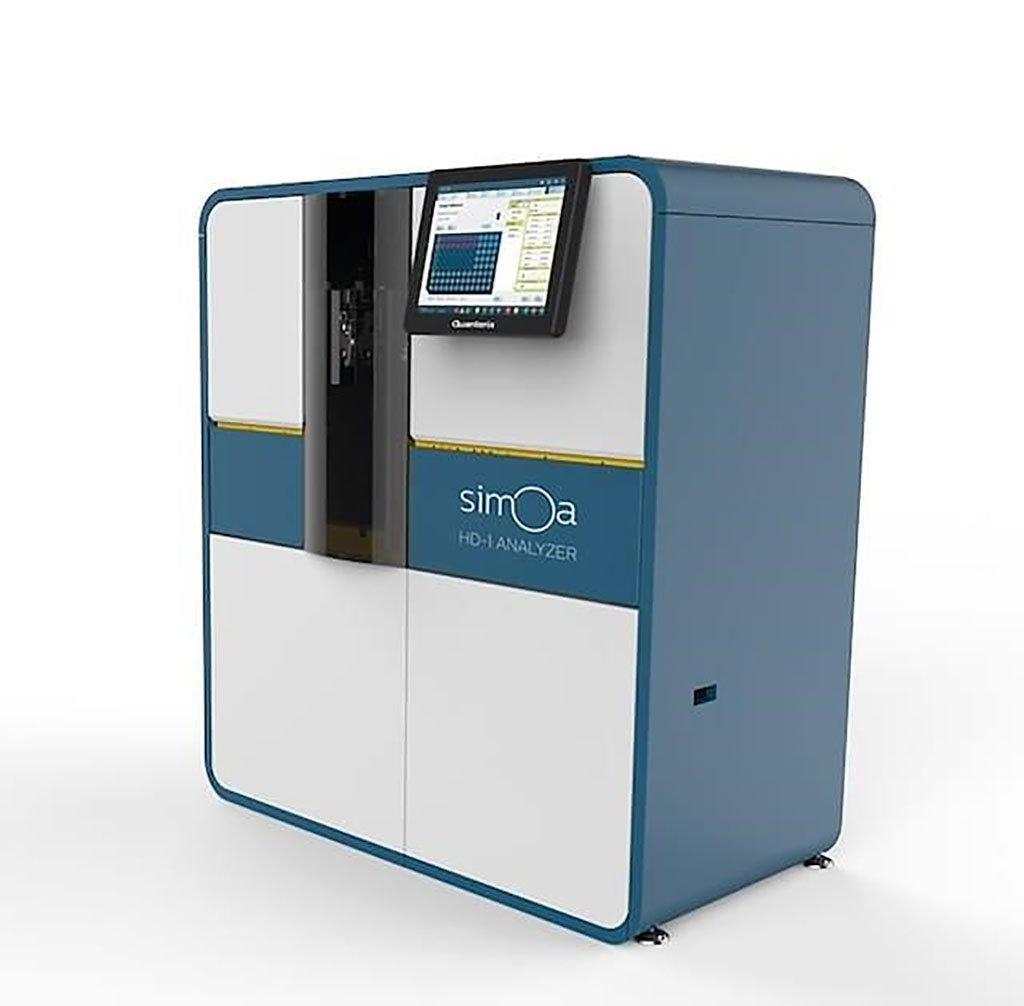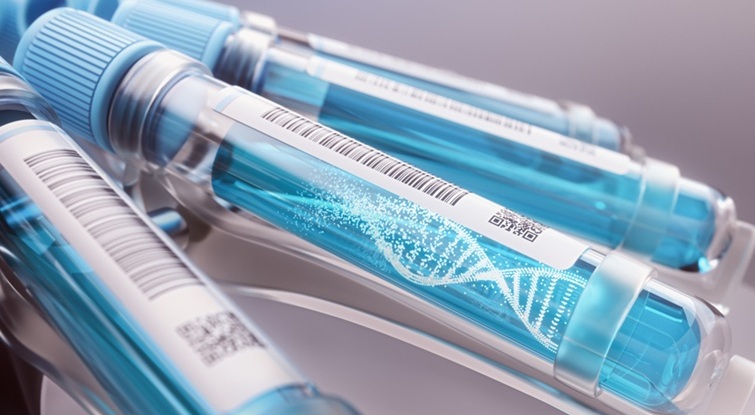Plasma Amyloid-β 42/40 Assays Compared in Alzheimer Disease
|
By LabMedica International staff writers Posted on 14 Oct 2021 |

Image: Simoa is an ultra-sensitive immunoassay technology that allow detection of proteins and nucleic acids at lowest possible levels (Photo courtesy of Quanterix)
Blood-based tests for brain amyloid-β (Aβ) pathology are needed for widespread implementation of Alzheimer disease (AD) biomarkers in clinical care and to facilitate patient screening and monitoring of treatment responses in clinical trials.
Reliable measurements of Aβ in blood proved challenging until the development of advanced mass spectrometry and immunodetection methods. Recent articles have suggested that Aβ42/40 quantified using ultrasensitive and fully automated immunoassay platforms could predict Aβ-PET status (especially when combined with APOE genotype) with accuracy approaching that of MS-based Aβ42/40 measures.
An international team led by Clinical Neuroscientists at Lund University (Lund, Sweden) compared the performance of plasma Aβ42/40 measured using eight different Aβ assays when detecting abnormal brain Aβ status in patients with early AD. The study included 182 cognitively unimpaired participants and 104 patients with mild cognitive impairment who were enrolled at three different hospitals in Sweden and underwent Aβ positron emission tomography (PET) imaging and cerebrospinal fluid (CSF) and plasma collection from 2010 to 2014.
Plasma Aβ42/40 was measured using an immunoprecipitation-coupled mass spectrometry developed at Washington University School of Medicine (IP-MS-WashU, St Louis, MO, USA), antibody-free liquid chromatography MS developed by Araclon (LC-MS-Arc, Zaragoza, Spain), and diverse immunoassays. Plasma Aβ42/40 was also measured using an IP-MS–based method from Shimadzu (Kyoto, Japan) in 200 participants (IP-MS-Shim) and an IP-MS–based method from the University of Gothenburg (IP-MS-UGOT, Gothenburg, Sweden) and another immunoassay, the N4PE Simoa immunoassay (IA-Quan, Quanterix Billerica, MA, USA) among 227 participants.
When the team identified participants with abnormal CSF Aβ42/40 in the whole cohort, plasma IP-MS-WashU Aβ42/40 showed significantly higher accuracy than LC-MS-Arc Aβ42/40, and some immunoassays. Plasma IP-MS-WashU Aβ42/40 performed significantly better than IP-MS-UGOT Aβ42/40 and IA-Quan Aβ42/40, while there was no difference in the AUCs between IP-MS-WashU Aβ42/40 and IP-MS-Shim Aβ42/40) in the two sub-cohorts where these biomarkers were available. Plasma IPMS-WashU Aβ42/40 and IP-MS-Shim Aβ42/40 showed highest coefficients for correlations with CSF Aβ42/40.
The authors concluded that the results from two independent cohorts indicate that certain MS-based methods performed better than most of the immunoassays for plasma Aβ42/40 when detecting brain Aβ pathology. The study was published on September 20, 2021 in the journal JAMA Neurology.
Related Links:
Lund University
Washington University School of Medicine
Araclon
University of Gothenburg
Quanterix
Reliable measurements of Aβ in blood proved challenging until the development of advanced mass spectrometry and immunodetection methods. Recent articles have suggested that Aβ42/40 quantified using ultrasensitive and fully automated immunoassay platforms could predict Aβ-PET status (especially when combined with APOE genotype) with accuracy approaching that of MS-based Aβ42/40 measures.
An international team led by Clinical Neuroscientists at Lund University (Lund, Sweden) compared the performance of plasma Aβ42/40 measured using eight different Aβ assays when detecting abnormal brain Aβ status in patients with early AD. The study included 182 cognitively unimpaired participants and 104 patients with mild cognitive impairment who were enrolled at three different hospitals in Sweden and underwent Aβ positron emission tomography (PET) imaging and cerebrospinal fluid (CSF) and plasma collection from 2010 to 2014.
Plasma Aβ42/40 was measured using an immunoprecipitation-coupled mass spectrometry developed at Washington University School of Medicine (IP-MS-WashU, St Louis, MO, USA), antibody-free liquid chromatography MS developed by Araclon (LC-MS-Arc, Zaragoza, Spain), and diverse immunoassays. Plasma Aβ42/40 was also measured using an IP-MS–based method from Shimadzu (Kyoto, Japan) in 200 participants (IP-MS-Shim) and an IP-MS–based method from the University of Gothenburg (IP-MS-UGOT, Gothenburg, Sweden) and another immunoassay, the N4PE Simoa immunoassay (IA-Quan, Quanterix Billerica, MA, USA) among 227 participants.
When the team identified participants with abnormal CSF Aβ42/40 in the whole cohort, plasma IP-MS-WashU Aβ42/40 showed significantly higher accuracy than LC-MS-Arc Aβ42/40, and some immunoassays. Plasma IP-MS-WashU Aβ42/40 performed significantly better than IP-MS-UGOT Aβ42/40 and IA-Quan Aβ42/40, while there was no difference in the AUCs between IP-MS-WashU Aβ42/40 and IP-MS-Shim Aβ42/40) in the two sub-cohorts where these biomarkers were available. Plasma IPMS-WashU Aβ42/40 and IP-MS-Shim Aβ42/40 showed highest coefficients for correlations with CSF Aβ42/40.
The authors concluded that the results from two independent cohorts indicate that certain MS-based methods performed better than most of the immunoassays for plasma Aβ42/40 when detecting brain Aβ pathology. The study was published on September 20, 2021 in the journal JAMA Neurology.
Related Links:
Lund University
Washington University School of Medicine
Araclon
University of Gothenburg
Quanterix
Latest Clinical Chem. News
- Compact Raman Imaging System Detects Subtle Tumor Signals
- Noninvasive Blood-Glucose Monitoring to Replace Finger Pricks for Diabetics
- POC Breath Diagnostic System to Detect Pneumonia-Causing Pathogens
- Online Tool Detects Drug Exposure Directly from Patient Samples
- Chemical Imaging Probe Could Track and Treat Prostate Cancer
- Mismatch Between Two Common Kidney Function Tests Indicates Serious Health Problems
- VOCs Show Promise for Early Multi-Cancer Detection
- Portable Raman Spectroscopy Offers Cost-Effective Kidney Disease Diagnosis at POC
- Gold Nanoparticles to Improve Accuracy of Ovarian Cancer Diagnosis
- Simultaneous Cell Isolation Technology Improves Cancer Diagnostic Accuracy
- Simple Non-Invasive Hair-Based Test Could Speed ALS Diagnosis
- Paper Strip Saliva Test Detects Elevated Uric Acid Levels Without Blood Draws
- Prostate Cancer Markers Based on Chemical Make-Up of Calcifications to Speed Up Detection
- Breath Test Could Help Detect Blood Cancers
- ML-Powered Gas Sensors to Detect Pathogens and AMR at POC
- Saliva-Based Cancer Detection Technology Eliminates Need for Complex Sample Preparation
Channels
Molecular Diagnostics
view channel
Urine Test Could Reveal Real Age and Life Span
Chronological age does not always reflect how quickly the body is aging, as biological age is shaped by genetics, stress, sleep, nutrition, and lifestyle factors such as smoking. A higher biological age... Read more
Genomic Test Identifies African Americans at Risk for Early Prostate Cancer Recurrence
Prostate cancer is one of the most commonly diagnosed cancers in men and a leading cause of cancer-related death, particularly in the United States. African American men face a disproportionately higher... Read moreHematology
view channel
MRD Tests Could Predict Survival in Leukemia Patients
Acute myeloid leukemia is an aggressive blood cancer that disrupts normal blood cell production and often relapses even after intensive treatment. Clinicians currently lack early, reliable markers to predict... Read more
Platelet Activity Blood Test in Middle Age Could Identify Early Alzheimer’s Risk
Early detection of Alzheimer’s disease remains one of the biggest unmet needs in neurology, particularly because the biological changes underlying the disorder begin decades before memory symptoms appear.... Read more
Microvesicles Measurement Could Detect Vascular Injury in Sickle Cell Disease Patients
Assessing disease severity in sickle cell disease (SCD) remains challenging, especially when trying to predict hemolysis, vascular injury, and risk of complications such as vaso-occlusive crises.... Read more
ADLM’s New Coagulation Testing Guidance to Improve Care for Patients on Blood Thinners
Direct oral anticoagulants (DOACs) are one of the most common types of blood thinners. Patients take them to prevent a host of complications that could arise from blood clotting, including stroke, deep... Read moreImmunology
view channel
Ultrasensitive Liquid Biopsy Demonstrates Efficacy in Predicting Immunotherapy Response
Immunotherapy has transformed cancer treatment, but only a small proportion of patients experience lasting benefit, with response rates often remaining between 10% and 20%. Clinicians currently lack reliable... Read more
Blood Test Could Identify Colon Cancer Patients to Benefit from NSAIDs
Colon cancer remains a major cause of cancer-related illness, with many patients facing relapse even after surgery and chemotherapy. Up to 40% of people with stage III disease experience recurrence, highlighting... Read moreMicrobiology
view channel
New UTI Diagnosis Method Delivers Antibiotic Resistance Results 24 Hours Earlier
Urinary tract infections affect around 152 million people every year, making them one of the most common bacterial infections worldwide. In routine medical practice, diagnosis often relies on rapid urine... Read more
Breakthroughs in Microbial Analysis to Enhance Disease Prediction
Microorganisms shape human health, ecosystems, and the planet’s climate, yet identifying them and understanding how they are related remains a major scientific challenge. Even with modern DNA sequencing,... Read morePathology
view channel
Genetics and AI Improve Diagnosis of Aortic Stenosis
Aortic stenosis is a progressive narrowing of the aortic valve that restricts blood flow from the heart and can be fatal if left untreated. There are currently no medical therapies that can prevent or... Read more
AI Tool Simultaneously Identifies Genetic Mutations and Disease Type
Interpreting genetic test results remains a major challenge in modern medicine, particularly for rare and complex diseases. While existing tools can indicate whether a genetic mutation is harmful, they... Read more
Rapid Low-Cost Tests Can Prevent Child Deaths from Contaminated Medicinal Syrups
Medicinal syrups contaminated with toxic chemicals have caused the deaths of hundreds of children worldwide, exposing a critical gap in how these products are tested before reaching patients.... Read more
Tumor Signals in Saliva and Blood Enable Non-Invasive Monitoring of Head and Neck Cancer
Head and neck cancers are among the most aggressive malignancies worldwide, with nearly 900,000 new cases diagnosed each year. Monitoring these cancers for recurrence or relapse typically relies on tissue... Read moreTechnology
view channel
Pioneering Blood Test Detects Lung Cancer Using Infrared Imaging
Detecting cancer early and tracking how it responds to treatment remains a major challenge, particularly when cancer cells are present in extremely low numbers in the bloodstream. Circulating tumor cells... Read more
AI Predicts Colorectal Cancer Survival Using Clinical and Molecular Features
Colorectal cancer is one of the most common and deadly cancers worldwide, and accurately predicting patient survival remains a major clinical challenge. Traditional prognostic tools often rely on either... Read moreIndustry
view channel
BD and Penn Institute Collaborate to Advance Immunotherapy through Flow Cytometry
BD (Becton, Dickinson and Company, Franklin Lakes, NJ, USA) has entered into a strategic collaboration with the Institute for Immunology and Immune Health (I3H, Philadelphia, PA, USA) at the University... Read more



















